 Given Two Sides and a Non-Included Angle, How Many Triangles? (Part 1)
Given Two Sides and a Non-Included Angle, How Many Triangles? (Part 1)
(This page is Part 1. Click here for Part 2.)
The ‘SSA’ triangle condition (two sides and a non-included angle), does not uniquely identify a triangle.
Given two positive real numbers (two side lengths) and a degree measure strictly between $\,0^\circ\,$ and $\,180^\circ\,$ (the angle), there may be no triangle, exactly one triangle, or two triangles that match the SSA information.
- The information in Is there an ‘SSA’ congruence theorem? No! is re-visited, adding details to determine precisely when you have zero, one, or two triangles.
- The arcsine function is quickly introduced (in Part 2), since it is needed to solve an SSA situation.
- Examples are given (in Part 2), using the Law of Sines to investigate SSA situations.
When Will You Have Zero, One, or Two Triangles in an ‘SSA’ Situation?
Let $\,a\,$ and $\,b\,$ be positive real numbers, used to denote lengths of two sides of a triangle. Let $\,\theta\,$ denote the measure of a non-included angle.
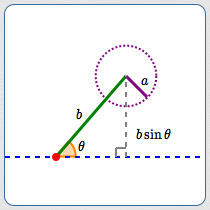
As shown above, $\,a\,,$ $\,b\,$ and $\,\theta\,$ form an ‘SSA’ situation—two sides and a non-included angle.
To significantly cut down on words, I say things like:
‘$\,a\,$ attaches to $\,b\,$’
instead of the more correct (but much wordier):
‘The side of length $\,a\,$ attaches to the side of length $\,b\,$’
Note that:
- ‘SSA’ corresponds to ‘$\,a\,b\,\theta\,$’
- $b\,$ attaches to $\,a\,$ at one end and has $\,\theta\,$ at the other end
- $a\,$ is opposite $\,\theta$
To sketch an SSA situation for given values of $\,a\,,$ $\,b\,$ and $\,\theta\,$:
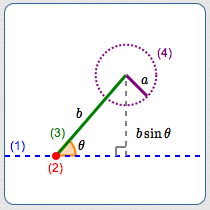
- Start by drawing a dashed line that will ‘hold’ the third (unknown) side of the triangle.
- Choose a point on the dashed line as the vertex for $\,\theta\,.$
- Attach the side of length $\,\color{green}{b}\,$ to the chosen vertex at angle $\,\color{orange}{\theta}\,.$
- At the other end of $\,b\,,$ attach a circle of radius $\,\color{purple}{a}\,$; the angle at which $\,b\,$ attaches to $\,a\,$ is initially unknown.
The altitude shown (which has length $\,b\sin\theta\,$) is an important boundary between different behaviors—keep reading!
In the following progression of sketches, $\,b\,$ and $\,\theta\,$ are held constant, and $\,\theta\,$ is an acute angle. The side of length $\,a\,$ gets bigger and bigger:
$0 \lt a \lt b\sin\theta$
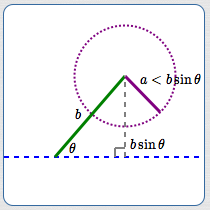
When $\,a\,$ is less than $\,b\sin\theta\,,$ it is too short to reach the dashed line. No matter what the angle is between $\,a\,$ and $\,b\,,$ the triangle cannot be completed.
For $\,0 \lt a \lt b\sin\theta\,,$ there is no triangle determined by sides $\,a\,$ and $\,b\,$ and a non-included angle $\,\theta\,.$

$0 \lt a \lt b\sin\theta$
No triangle determined by $\,a\,,$
$\,b\,$ and $\,\theta\,$
$a = b\sin\theta$
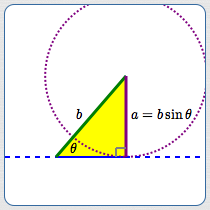
When $\,a\,$ reaches the altitude length ($\,a = b\sin\theta\,$) then it is just long enough to hit the dashed line and form a (right) triangle.
For $\,a = b\sin\theta\,,$ there is exactly one (right) triangle determined by sides $\,a\,$ and $\,b\,$ and a non-included angle $\,\theta\,.$

$a = b\sin\theta$
Exactly one (right) triangle
determined by $\,a\,,$ $\,b\,$ and $\,\theta$
$b\sin\theta \lt a \lt b$
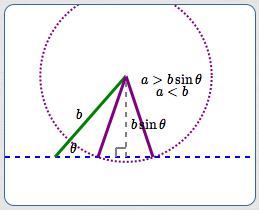
This is the most interesting case! This case is the reason there is no ‘SSA’ congruence theorem.
For values of $\,a\,$ strictly between $\,b\sin\theta\,$ and $\,b\,,$ the circle of radius $\,a\,$ intersects the dashed line at two different points.
Therefore, there are two different triangles that meet the SSA information.
For $\,b\sin\theta \lt a \lt b\,,$ there are two different triangles determined by sides $\,a\,$ and $\,b\,$ and a non-included angle $\,\theta\,.$

The two triangles determined by $\,a\,,$ $\,b\,$ and $\,\theta\,$:
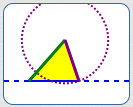
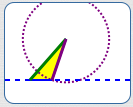
$\,b\sin\theta \lt a \lt b\,$
Two different triangles determined by $\,a\,,$ $\,b\,$ and $\,\theta\,$
$a = b$
For $\,a = b\,,$ there is exactly one isosceles triangle determined by sides $\,a\,$ and $\,b\,$ and a non-included angle $\,\theta\,.$
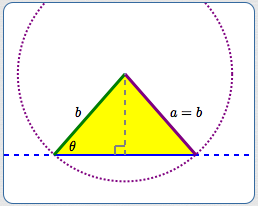
$a = b$
Exactly one isosceles triangle
$a \gt b$
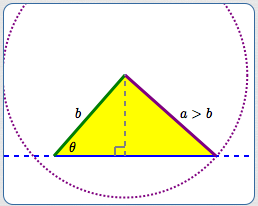
When $\,a\,$ is greater than $\,b\,,$ then the circle of radius $\,a\,$ intersects the dashed line at two different points. However, only one of these points gives a triangle with interior angle $\,\theta\,.$
For $\,a \gt b\,,$ there is exactly one triangle determined by sides $\,a\,$ and $\,b\,$ and a non-included angle $\,\theta\,.$

$a \gt b$
Exactly one triangle
Summary: Boundaries for Zero, One, Two Triangles in an SSA Configuration
This graphic summarizes the ‘SSA’ situations discussed above.
Side $\,b\,$ and angle $\,\theta \lt 90^\circ\,$ are fixed. The number line shows the values of $\,a\,$ corresponding to no, one, and two triangles.

The red (no $\,\triangle\,$), blue (two $\,\triangle\,$s), and black (one $\,\triangle\,$) intervals change depending upon the values of $\,b\,$ and $\,\theta\,.$
Put in your own values for $\,b\,$ and $\,\theta\,$ below—have fun!
Play With SSA Configurations
Type in desired values for $\,b\,$ and $\,\theta\,$ below. Then, click the ‘Create Number Line Summary’ and ‘See the Triangle’ buttons.
Note: If $\,\theta\,$ is an obtuse angle (or a right angle), then the situation is different. In this case, no triangle exists until $\,a \gt b\,,$ at which point there is a unique triangle:
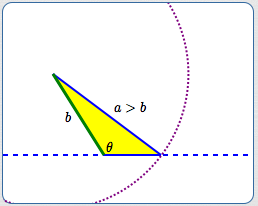
Practice Sketching SSA Cases
Get a random SSA situation by clicking below. Sketch the given situation on a piece of paper—make it roughly to scale, but don't actually measure anything. Based on your sketch, make a conjecture as to how many triangle(s) meet this SSA configuration. Then, check your conjecture.